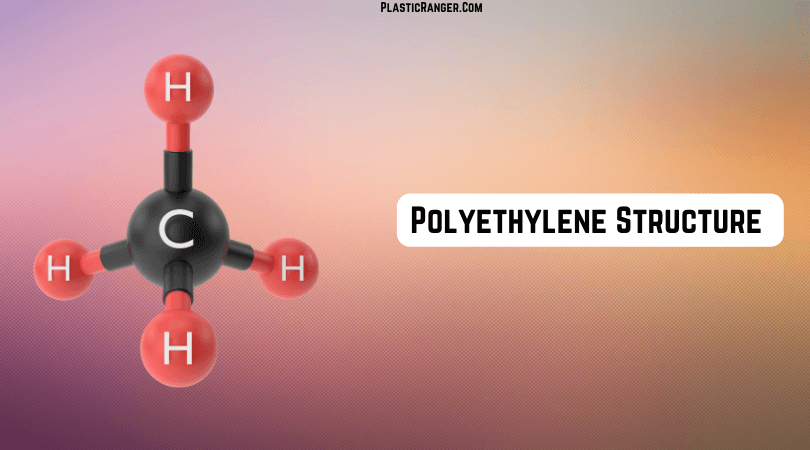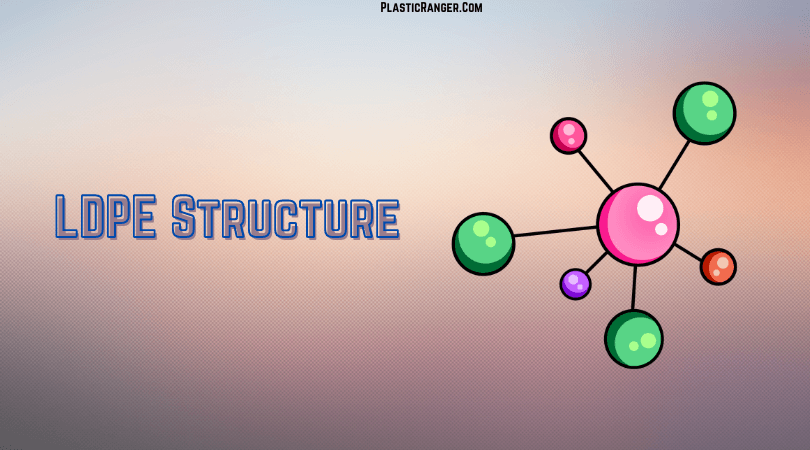Polyethylene Structure
Polyethylene is a versatile thermoplastic with diverse uses and is recognized for its variable crystalline structure.

This lightweight yet robust material is among the most widely used thermoplastics in the world, with countless tons being put into service globally.
It’s employed in various products, such as detergent containers, shopping bags, and food packaging, to name a few.
This material is classified under polyolefin resins. Standard practices include converting PE into synthetic fibers through slitting and spurning, a process similar to that used with rubber, to alter its properties.
Polyethylene (C2H4)n is created by polymerizing ethylene monomers derived from petroleum.
This article will offer a comprehensive examination of the structure of polyethylene, exploring how it influences the general properties of the polymer and other pertinent considerations.
The Basic Structure of Polyethylene
At its most basic level, polyethylene consists of a long chain of carbon atoms, each attached to two hydrogen atoms.
These carbon-carbon chains, formed from the polymerization of ethylene monomers (C2H4), generate a highly versatile and adaptable structure.
This structure, known as a polymer, is characterized by repeating subunits, the ethylene monomers in this case.
How these subunits connect – their sequence, length, and degree of branching – fundamentally influences the properties of the resultant polyethylene.
Variations in Polyethylene Structure
The arrangement of the polymer chain gives rise to two primary types of polyethylene – High-Density Polyethylene (HDPE) and Low-Density Polyethylene (LDPE). LDPE, the first type of polyethylene to be developed, possesses a highly branched chain structure.
The branches prevent the polymer chains from packing closely, leading to a less dense, more flexible, and lower-strength material. Consequently, LDPE finds common usage in applications like plastic bags, plastic wraps, and squeeze bottles.
Conversely, HDPE exhibits a linear structure with minimal branching. This configuration allows the chains to pack closely together, resulting in a denser, stronger, and more rigid material.
HDPE’s robust nature lends itself to more demanding applications, including detergent bottles, piping, and fuel tanks.
The Anatomy of HDPE Structure

The HDPE structure comprises carbon and hydrogen atoms, as is typical with hydrocarbons.
Each carbon atom is bonded to two other carbon atoms and two hydrogen atoms, resulting in a chain-like structure.
This is due to the sp3 hybridization of carbon, which enables it to form four covalent bonds.
The arrangement of atoms in HDPE results in long linear chains that pack closely together, making the structure more dense and crystalline than other polyethylene types, such as Low-Density Polyethylene (LDPE).
Crystallinity and density are critical factors determining the mechanical properties of HDPE. Higher crystallinity improves tensile strength, impact resistance, and dimensional stability.
Meanwhile, higher density results in lower permeability, making HDPE suitable for applications where barrier properties are required, such as in packaging for food and beverages.
Another significant aspect of HDPE’s structure is the lack of branching. The linear arrangement of the chains with no or minimal side branches allows the molecules to pack tightly together, resulting in a higher density.
This high-density packing also contributes to the rigidity, toughness, and high melting point of HDPE, making it ideal for applications that require superior strength and temperature resistance.
However, HDPE does exhibit some degree of chain branching, though in a controlled and limited manner. This happens through copolymerization with alpha-olefins such as hexene, butene, or octene.
Including these molecules provides short-chain branching, further enhancing the material’s properties, such as environmental stress crack resistance (ESCR). The choice of comonomer and its proportion can be adjusted to fine-tune the properties of HDPE for specific applications.
The Anatomy of LDPE Structure

The fundamental structure of LDPE is similar to HDPE, with a carbon backbone and two hydrogen atoms attached to each carbon atom. However, a high-pressure radical polymerization method is used during the LDPE polymerization process. This process forms long-chain molecules with significant amounts of short and long branches. The branching in LDPE’s structure is crucial to its properties.
These branches prevent the chains from packing closely together, leading to a lower density.
The less compact structure gives LDPE its unparalleled flexibility and resilience, making it an ideal choice for applications that require these characteristics, such as flexible packaging materials and squeezable bottles. The branching in LDPE also impacts its mechanical properties and thermal behavior.
The loosely packed structure decreases its tensile strength and rigidity compared to HDPE but significantly increases its elasticity. Moreover, the presence of branches leads to a lower melting point, making LDPE suitable for applications where high-temperature resistance is not a priority.
The structural configuration of LDPE also results in lower crystallinity compared to HDPE. The difference between LDPE VS HDPE structural configuration is the former’s lower crystallinity compared to later
The abundance of branches disrupts the alignment of the molecular chains, limiting the formation of ordered, crystalline regions.
This lower crystallinity contributes to the softness and flexibility of LDPE. Moreover, LDPE’s amorphous nature and lack of crystallinity also lead to its excellent clarity.
It is more transparent than other types of polyethylene, which explains why it is commonly used for applications where transparency is a vital requirement, such as food packaging and wrapping films.
The branching of LDPE can be controlled to some extent to achieve specific properties. For instance, including comonomers like vinyl acetate or butyl acrylate during polymerization can increase the number of short-chain branches, enhancing properties such as clarity, sealability, and resistance to environmental stress cracking.
Summary
To summarize, the structure of polyethylene, characterized by long-chain hydrocarbon molecules, is crucial to its unique attributes. The degree of branching and density significantly impact its properties, leading to the various forms, including LDPE and HDPE. Understanding the intricacies of polyethylene’s structure offers insights into its versatility, facilitating innovative applications and tailoring its properties to suit diverse industrial needs.
Quick Navigation
